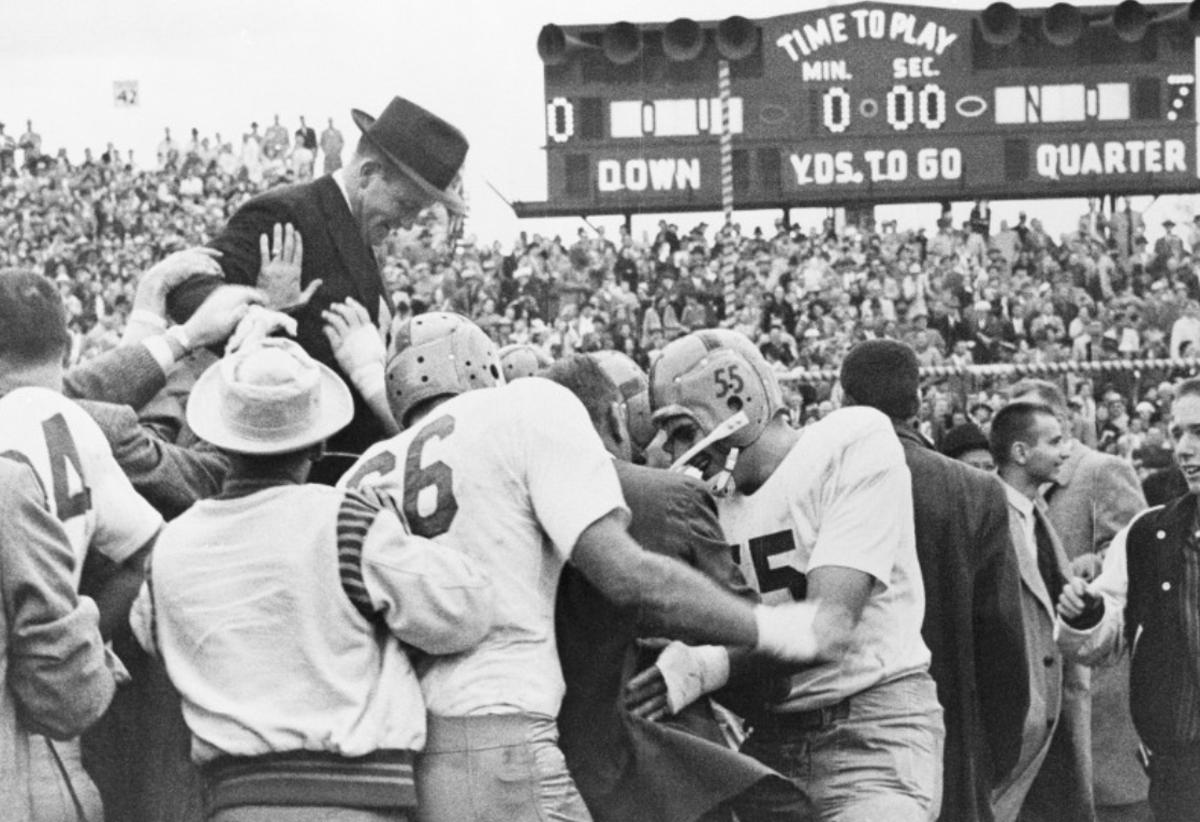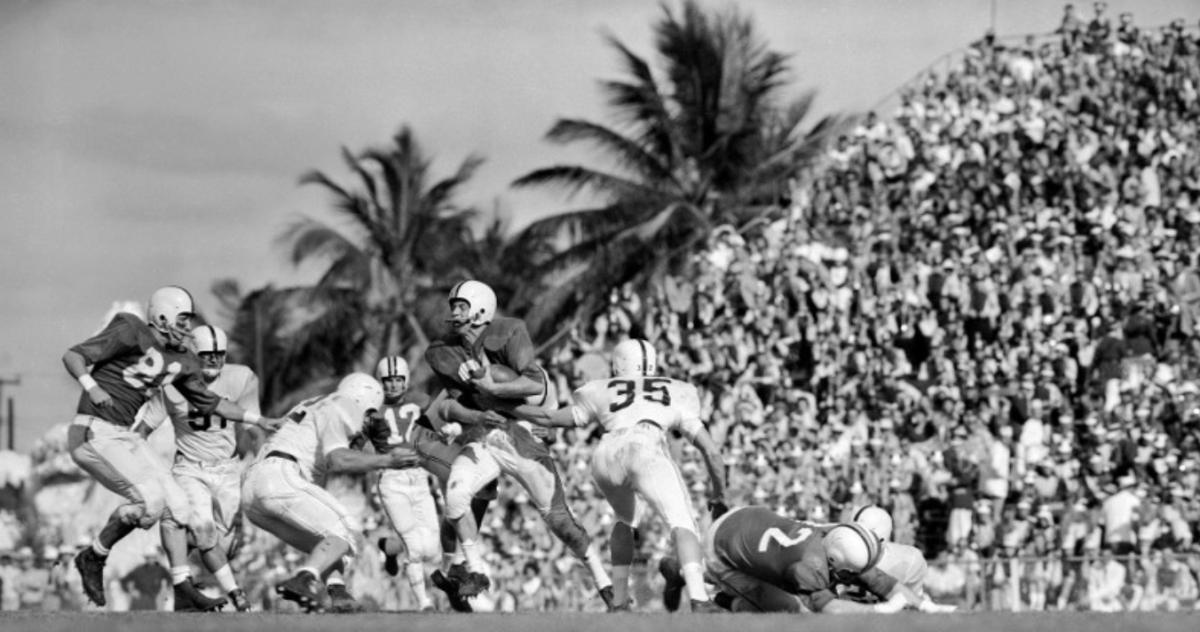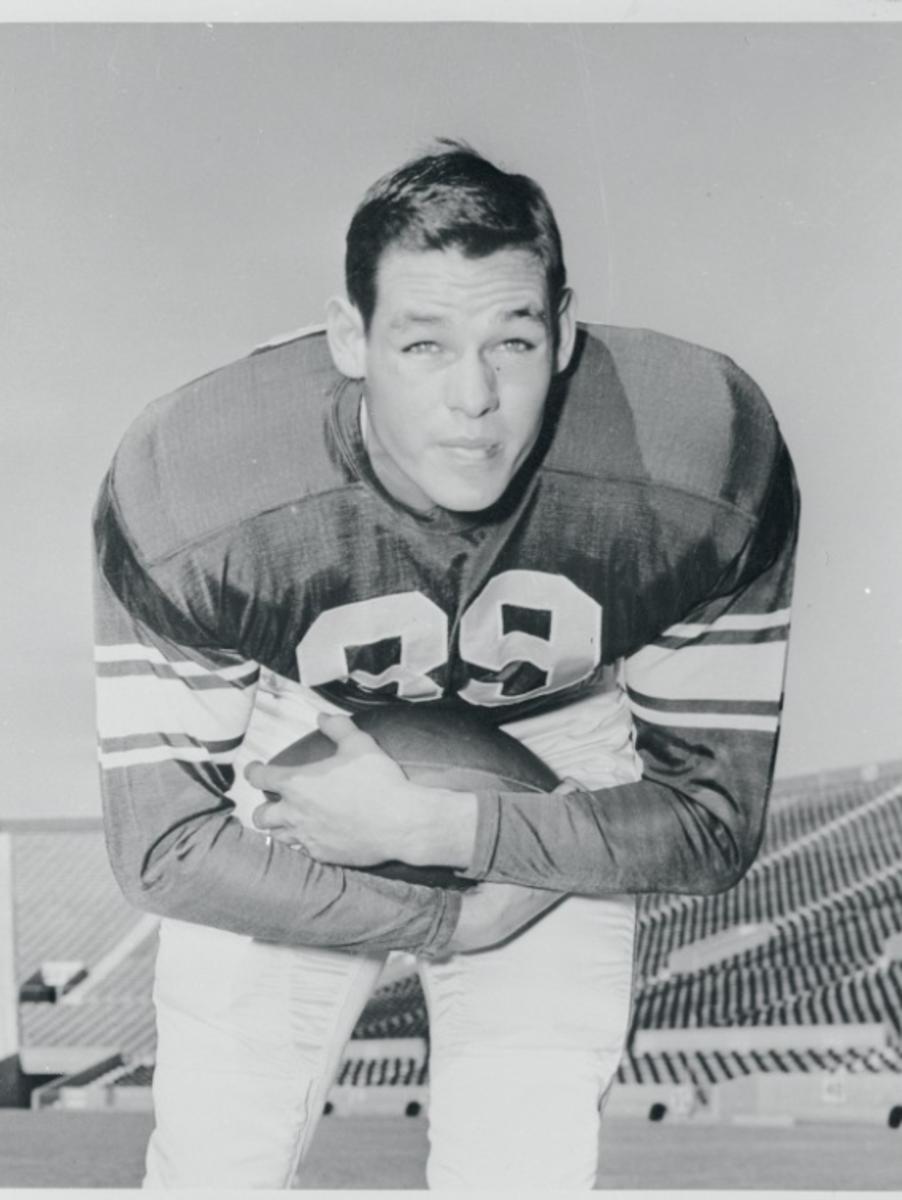Hang Half-a-Hundred on 'Em: Looking Back on OU's 50 Conference Titles: Part 4

In 2020, the Oklahoma Sooners won their 50th conference title, four more than second place Nebraska. Every Friday this summer in our Hang Half-a-Hundred on ‘Em series, SI Sooners takes a look back at every single conference championship season in OU history.
1959: Decade of Dominance

The final of 14 straight conference titles, the 1959 season capped off an entire decade of Oklahoma dominance. Led by running back Prentice Gautt, the first Black player to earn a scholarship at the University of Oklahoma, the season started out under dubious circumstances. Traveling to play Northwestern for the season opener, reportedly 20 Sooners mysteriously fell ill after visiting a Chicago nightclub on the eve of the contest. The outbreak coincided with a massive move in the betting line on the game, as it moved from OU being 6-point favorites to just 3-point favorites overnight. The ensuing battle would be anything but competitive, as the Wildcats went on to win 45-13, the worst defeat of Bud Wilkinson’s career. Two weeks later, Wilkinson’s Sooners would fall 19-12 to the No. 4-ranked Texas Longhorns in the Cotton Bowl. But OU rallied to win six of its last seven games, including a decisive 23-0 win over the Big Seven’s second-place team in Missouri, to cap off the program’s 20th conference title. Gautt would finish the year with 674 yards on 130 rushing attempts, eventually getting drafted with the No. 10 pick in the second round of the NFL Draft by the Cleveland Browns.
1958: Shifting Fortunes in Dallas

Oklahoma entered 1958 ranked No. 2, and immediately reeled off a 47-14 win over No. 13-ranked West Virginia and a 6-0 win over the Oregon Ducks before heading to Dallas to lock horns with Texas. Facing his former pupil Darrell Royal for the second time in the Cotton Bowl, Wilkinson’s team would come up short, beginning a run of six straight losses to the ‘Horns. After neither side gained a first down over the first 10 minutes of the game, Royal stunned the Sooners by taking advantage of a new rule for the 1958 season and attempting a 2-point conversion after Texas scored the first touchdown of the day. Converting the attempt, the Longhorns led 8-0 early before Oklahoma reeled off 14 unanswered points. But with time running out, Royal made a quarterback change that sparked a 13-play drive. Vince Matthews marched his team down the field, scoring the decisive touchdown to upset the Sooners 15-14. OU would respond by winning out, dominating Big Seven opponents by a combined score of 212-20. In a Top-10 Orange Bowl battle against the Syracuse Orange, a Gautt touchdown, Brewster Hobby 79-yard touchdown pass and then a 40-yard punt return from Hobby sealed a 21-6 victory in Miami.
1957: The Streak is Broken

Stunned silence reportedly hung over Norman on Nov. 16, 1957. Failing to score three different times after driving the ball deep into Notre Dame territory, the Oklahoma Sooners would rue their missed opportunities for the first time in 47 games— when OU also fell to the Fighting Irish. Dick Lynch punched the ball in the end zone late in the fourth quarter, all the offense Notre Dame would need to win 7-0 and hand running back Clendon Thomas his only loss as a Sooner. Despite dominating all challengers outside of Notre Dame, the Sooners finished fourth in both the AP and Coaches Poll, ending their hopes of back-to-back-to-back National Championships. Over the course of the season, Thomas ran for 905 yards on 144 attempts, posting an astonishing 6.3 yards per carry, but the loss to the Fighting Irish would linger and Oklahoma wouldn’t sit atop the college football mountain for another 17 years. OU rebounded with three straight wins over rivals Nebraska and Oklahoma State and finishing the year with a 48-21 victory over the No. 16-ranked Duke Blue Devils in the 1958 Orange Bowl.
1956: Going Back-to-Back

Overcoming criticisms of a soft schedule, Wilkinson’s Sooners dominated nearly every team on their schedule to capture their second straight national title. Led by All-American center Jerry Tubbs, and the era’s greatest 1-2 punch in Tommy McDonald and Clendon Thomas, OU averaged 46.6 points per game. The Sooners also set the new mark for yards per game, racking up 391 yards a contest. The closest the Sooners came to defeat was when they took a trip to play the Colorado Buffaloes. Wilkinson’s team fell behind two touchdowns early, but they steadied the ship and ended up winning 27-19. Oklahoma also recorded a rare hat trick of victories, beating Texas, Notre Dame and Nebraska in the same season. Outscoring the Longhorns, Fighting Irish and Cornhuskers 139-6, the Sooners left no doubt as to who the best team in college football was, getting voted champions by both the AP and the Coaches. Oklahoma didn’t get the opportunity to compete in the Orange Bowl, as they fell victim to the Big Seven’s No Repeat Rule, preventing the same team from heading to Miami in consecutive seasons.
1955: McDonald’s Massive Performance in Miami

Not having lost since 1953, OU opened the 1955 season as the No. 3-ranked team in the country. A slow start in the form of a 13-6 win at North Carolina and a 26-14 victory over the No. 18 Pittsburgh Panthers halted Oklahoma’s momentum in the polls early on. But as quarterback Jimmy Harris settled in, Oklahoma would lean on him, McDonald and Thomas to impose their will on their opponents. Beating the Texas Longhorns 20-0, OU started a steady climb to the top of the polls, as they finally had control of the top spot after beating Kansas State 40-7 at the end of October. Closing the regular season undefeated, the Sooners earned a berth to the Orange Bowl against the No. 3-ranked Maryland Terrapins. The ACC Champions would take a 6-0 lead in the second quarter on the back of a Ed Vereb touchdown. OU’s offense would respond in lighting-quick fashion at the start of the second half, running three plays in under a minute, culminating in a McDonald touchdown to give the Sooners the 7-6 lead. A Carl Dodd 82-yard interception return for a touchdown sealed the 21-6 win and the program’s second national championship.
1954: Close, but no Cigar

Max Boydston and Kurt Burris led the Sooners to their first of three consecutive undefeated seasons, but Oklahoma would ultimately fall short of winning a second national title in 1954. The Sooners opened the season with three straight wins over ranked opponents. First heading to take on the No. 12-ranked California Bears, OU overpowered the Bears to a 27-13 victory on ABC. But it was a Week 2 matchup against the TCU Horned Frogs that became the stuff of urban legend. As the story goes, TCU’s Johnny Crouch helped officials overturn a Horned Frog touchdown because he didn’t think his teammate caught the ball in an impressive display fo sportsmanship. Though the story was denied at the time by Crouch, the pass was ruled incomplete nonetheless, allowing the Sooners to climb out of an early hole and beat TCU 21-16. Oklahoma continued its momentum, beating Texas 20-0 the next week as Bob Herndon and Jerry Tubbs began to find their groove for Wilkinson’s offense. The Sooners outscored their Big Seven opponents by a combined score of 242-26, finishing the season ranked third in both major polls.
1953: Birth of the Streak

Struggling to replace 1952 Heisman Trophy winner Billy Vessels, Oklahoma stumbled out of the gate in 1953. The Sooners took the fight to top-ranked Notre Dame in their season opener, but were unable to outlast the Irish, losing 28-21. In their next game at Pittsburgh, OU played to a 7-7 draw, the last time they wouldn’t leave a stadium victorious for 47 games. A week later, returning Korean War veteran Tom Carroll would play the finest game of his football career. Carroll scored a 48-yard touchdown on the ground and picked off a pass to push OU to a 19-14 victory, its second of six straight wins over the ‘Horns. Carroll unfortunately suffered a knee injury shortly after, essentially ending his football career. Oklahoma ran roughshod over the Big Seven, beating second-place Missouri 14-7 to seal a trip to the Orange Bowl against top-ranked Maryland, headed by former OU head coach Jim Tatum. In a struggle against the potent Terrapins defense, Larry Grigg led the way for the Sooners with 89 yards on the ground, including the decisive touchdown in the second quarter. Though Oklahoma won 7-0, Maryland had been named National Champions before bowl season kicked off. OU was retroactively named joint-champions with Notre Dame by some polls, but Wilkinson declined to accept the title.
1952: The First Heisman

Opening the season with a 21-21 tie at Colorado, 1952 would become Billy Vessels’ greatest season as a Sooner, capturing the program’s first Heisman Trophy. Led by Vessels, OU’s high-flying offense then reeled off five straight victories, including a 49-20 victory over Texas, before heading to South Bend to link up with the Notre Dame Fighting Irish. In the first-ever nationally televised college football game, Vessels dazzled in a defeat. The Cleveland, OK, product reeled off a 44-yard touchdown run, a 62-yard touchdown run and a 27-yard touchdown reception to account for all of Oklahoma’s points in the 27-21 loss. Vessels finished the year with 1,072 rushing yards and 17 touchdowns on the ground, adding another two passing touchdowns as he did a little bit of everything for Wilkinson. The next week, Oklahoma bounced back with a 47-7 win over the Missouri Tigers, essentially clinching the Big Seven title over the second-place Tigers. After the season, Vessels would go on to be selected by the New York Giants with the second pick in the draft, but he instead elected to sign with the Edmonton Eskimos of the Canadian Football League. He only played one year in Canada, but he won the CFL Player of the Year award before serving a one-year term as an Army officer.
1951: Championship Hangover
On the heels of the program’s first national title, the Oklahoma Sooners came up short in back-to-back weeks during their non-conference slate, ending their hopes of repeating as champions before the season really got underway. After drubbing William & Mary in the season opener, Wilkinson took his Sooners down to College Station to face off with the No. 10-ranked Texas A&M Aggies. Quarterback Eddie Crowder was unable to lead OU to victory on the road, as Oklahoma fell 14-7. A week later, Oklahoma was unable to rebound in the Cotton Bowl, losing a heartbreaker to the Texas Longhorns 9-7, in which star halfback Billy Vessels sustained an injury where he had to be stretchered off the field, dashing Oklahoma’s hopes of getting back into the national title hunt. As they transitioned into Big Seven play, OU returned to dominance. Beating Kansas and Colorado in consecutive weeks, Oklahoma also shut out Nebraska 27-0 and routed Oklahoma A&M 41-6 to finish 6-0 in conference play and secure conference championship No. 12 for the program.
1950: Oklahoma’s Arrival

Entering the season with relatively low expectations, Wilkinson’s Sooners shocked the college football world and won their first National Championship. Led by All-Americans Leon Heath and Jim Weatherall, Wilkinson also got 15 touchdowns from a young Billy Vessels to help pace his explosive offense. OU had to pull off a great escape in the second game against Texas A&M, however, as Claude Arnold pitched the ball to Heath for the go-ahead touchdown with under a minute left. A week later, Oklahoma again trailed late, this time 13-7 against Texas, with under five minutes left on the clock. A botched snap on a punt for the Longhorns handed the Sooners the ball on the Texas 11-yard line, and Vessels cashed in for the game-winning touchdown to keep his team’s record unblemished. The Sooners then started to roll. Soundly beating each member of the Big Seven Conference, OU closed with a 49-35 win over Nebraska and a 41-14 win over Oklahoma A&M to seal the national title. Oklahoma actually lost to Bear Bryant’s Kentucky squad 13-7 in the Sugar Bowl, but it wouldn’t matter as the Sooners finished atop the regular-season polls.
